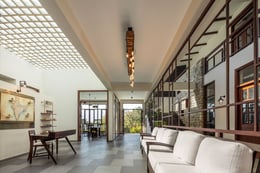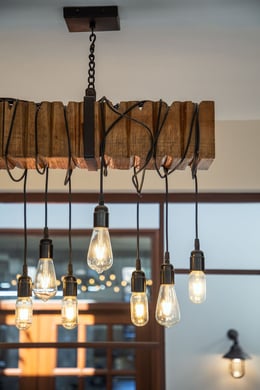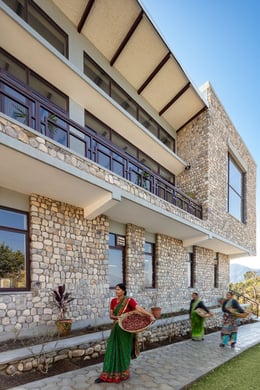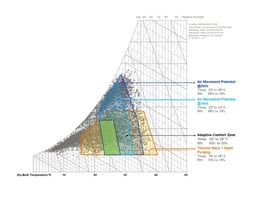Login
Registered users

The Lodsi Community Project, commissioned by Forest Essentials, is nestled in the Himalayan foothills near Rishikesh, Uttarakhand, India. The brief stipulated by the client outlined the construction of a production facility for a skin care company that focusses on reviving the ancient science of Ayurveda. The brand’s philosophy of infusing ancient wisdom with contemporary aesthetics presented us with an opportunity to adapt vernacular construction techniques to create a modern manufacturing facility. The Lodsi village lacks basic infrastructure such as electricity, water, and roads among other amenities. Most of the native community within the region migrates to cities for employment. The Lodsi Community Project was completed during the pandemic and serves as an exemplar for decentralised industrialisation. This production facility successfully demonstrates off-grid sustainability and is net-zero on energy, water, and waste. Through our design strategy we were able to generate employment for the local community, who now walk to work and were spared from the catastrophes of dislocation and reverse migration. We improvised local materials and construction techniques to support the ‘un-skilled hill people” in building the facility, much as they build their own homes. The built form draws inspiration from the traditional Garhwali ‘Kholi’ (house). A rectilinear volume oriented along the East-West axis was planned, with a central entry that divides the facility into two parts. Functions that require a cooler environment such as herb grinding, packaging, and storage, are located on the upper floor, whereas preparatory functions such as oil extraction, with other high internal heat-gain processes, are on the lower floor. The North-South oriented butterfly roof enabled the provision of large openable windows that allow prevailing North-East and South-East winds to enter the premises for ventilation. Furthermore, these fenestrations allow for 80% naturally day-lit spaces and unobstructed views of the valley. The high-volume of space, with operable clerestory windows, enforces Bernoulli’s principle and moderates indoor temperature. A central light-well forms a multi-purpose communal space, while also doubling up as a ‘mother and child wellness camp’ and ‘community space for students’ post school. Passive design strategies and indigenous construction techniques resulted in a strong architectural expression, one that contextually blends with the regional architecture and upholds community pride. Façade shading, window-to-wall ratio and building materials were optimised to ensure a high thermal-mass façade, resulting in an energy-efficient building envelope with an EPI of 38kWh/m2/year. A solar roof generating 55kWp of energy offsets the facility’s requirement and generates surplus electricity to supply back to the grid, hence the facility can be termed as ‘Energy+.’ A site-specific rainwater collection pit, storage tank and treatment system, along with an effluent treatment plant offsets the water requirements of the entire project. Waste materials from the site were repurposed and used within the facility. For instance, reclaimed wooden rafters were used as light fixtures, waste purlin sections as tube light holders, stone chisels as door handles, and re-bar as washbasin pedestal, among other such examples. All organic by-products are either reused or composted within the site. Therefore, this project is net-zero on energy, water, and waste. Our design strategy incorporated the existing ‘Gaushala’ (cow shed) for production of milk-based products. 65 villagers were involved in building this project and in turn the facility now supports 45% of the village households directly, while also supporting the entire village indirectly. The use of vernacular techniques, traditional materials and village labour form the ethos of the facility, thereby making it ‘a project for the locals, built by locals and for the employment of locals.’ The Lodsi Community Project addresses the aspects of socio-cultural and economical sustainability. It will serve as an archetype in the coming decades, as decentralised community-driven architecture becomes the norm in the wake of the pandemic. This facility stayed functional throughout the pandemic, and we believe this is the exemplar for future growth across the subcontinent.

























Established by Sonali and Manit Rastogi in 1996, Morphogenesis has developed an architectural language which is contextual and climatically sensitive. Our works are rooted in the cultural, social, and economic conditions of the region. Since the firm’s inception, we have successfully created exemplars that consume 50-70% lesser energy than established green rating benchmarks, without incurring any additional cost. Optimization of all resources is a pre-requisite to our architecture today and this has conservatively resulted in over 9 million sq.m. of built environment benefitting over 5,60,000 inhabitants, while also saving 22 billion litres of freshwater, 4.1 billion kW/hr of energy and a reduction in carbon dioxide emissions by 3.3 billion kg. Morphogenesis has copyrighted its design process S.O.U.L.©2019, an acronym for sustainable, optimized, unique, and liveable. The firm has won over 120 international and national awards, and has been featured in 900+ publications.